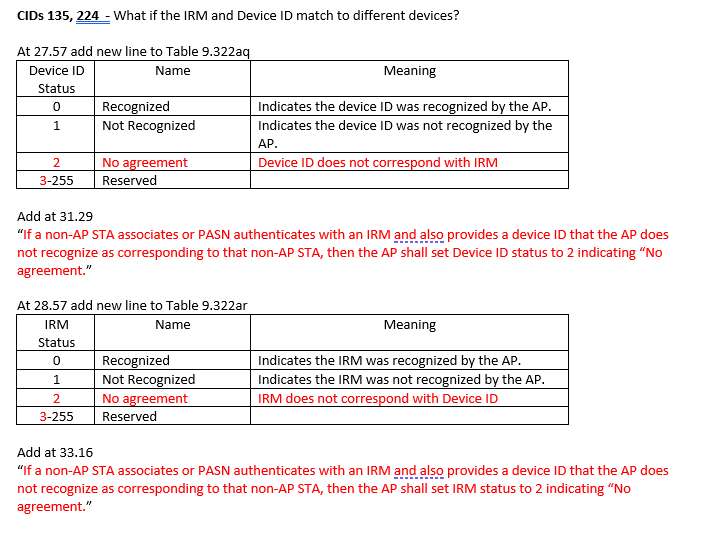Hi Antonio,
That resolution only covers CID 23 but does not really cover the other CIDs, except to say, “no problem”.
< IRM enables an AP to recognize that a STA has been associated previously to the AP,
therefore not providing any identification>
I feel that the IRM does identify the STA and the AP may well have lined up some credentials for it, such as allowing to associate.
CIDs 135 and 224 cover the case of no agreement and I thought the TG was leaning towards a status code? I was asked to look into that.
Here is a possible proposal for CIDs 135 and 224 if we choose that route. Probably needs some word smithing.

CIDs 135, 224 -
What if the IRM and Device ID match to different devicesGra
Graham
From: ANTONIO DE LA OLIVA DELGADO <aoliva@xxxxxxxxxx>
Sent: Friday, July 28, 2023 2:44 AM
To: stds-802-11-TGbh@xxxxxxxxxxxxxxxxx; G Smith <gsmith@xxxxxxxxxxxxxxxxxxx>
Subject: CIDs 23, 135 and 224
Dear all,
as promised during the last AC I am providing new text for the resolution of these CIDs.
Current text agreed during comment resolution for these CIDs is the following:
NOTE: Device ID and IRM are independent schemes that allow an AP to recognize a non-AP STA prior to association and identify it during association respectively. The device ID is allocated by an AP, and the IRM is selected by a non-AP STA.
If an AP and a non-AP STA both support both IRM and device ID, the non-AP STA might provide both an IRM and a device ID.
I think this explanation lacks information on how to proceed if both mechanisms while used concurrently yield to different results. In addition, the above paragraph seems to indicate IRM provides identification, while it is not.
I am proposing the following text, let me know what do you think
NOTE: Device ID and IRM are independent schemes that can be used concurrently. The device ID is allocated by an AP, and enables identification of the STA during association. IRM enables an AP to recognize that a STA has been associated previously to the AP,
therefore not providing any identification. If an AP and a non-AP STA both support both IRM and device ID, the non-AP STA might provide both an IRM and a device ID. Both mechanisms are not related and their failure or success is not linked.
Br
Antonio
--
Antonio de la Oliva
Associate Professor
Telematics Department
Universidad Carlos III de Madrid
E-mail: aoliva@xxxxxxxxxx
Phone: +34 91 624 8803
Fax: +34 91 624 8749
To unsubscribe from the STDS-802-11-TGBH list, click the following link: https://listserv.ieee.org/cgi-bin/wa?SUBED1=STDS-802-11-TGBH&A=1